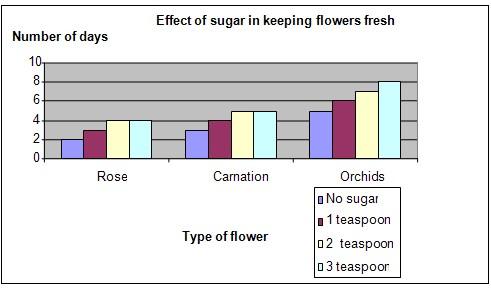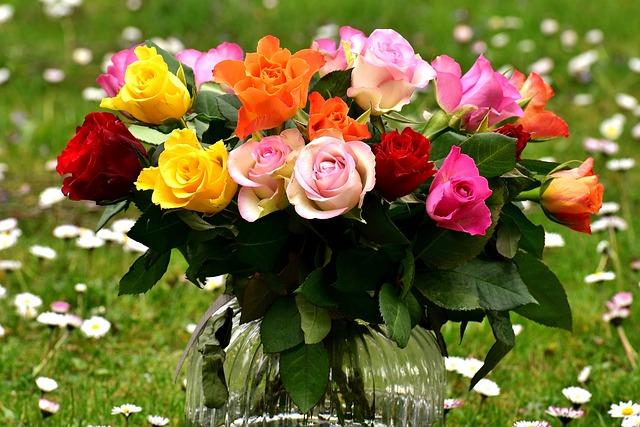| Complexity level: | 4 |
| Project cost ($): | 20 |
| Time required: | Preparations of the experimental setup will take approximately one day, after which observations will be carried out over a period of ten days |
| Material availability: | Easily found at a florist |
| Safety concerns: | Basic safety requirements |
Hypothesis
Flowers that are in contact with a more concentrated sugar solution will be able to last longer.
Overview
Keeping flowers fresh
"Beautiful" and "sweet-smelling" are two common terms that describe fresh flowers, and explains why so many of us like to place flowers in our homes. Having flowers in our homes adds color and a soft touch. In addition, the presence and scent of flowers gives us a psychological boost making us feel happier and livelier. Flowers certainly do help brighten up our day. However, fresh cut flowers do not last long as they typically wilt after a few days.
There are a few ways to help flowers stay fresh for longer periods of time, once they are cut. One method is to cut the stem of the flower at an angle with a sharp knife and immediately placing the cut flower in lukewarm water. Cutting a flower stalk at an angle exposes more of the stem, allowing for a larger surface area to come in contact with water. Leaves that are under water should be removed. Interestingly, the removal of rose thorns will hasten the wilting process of roses.
Another commonly used method is to add sugar and vinegar to water. Sugar is thought to provide the nutrition required by the flower, while a few drops of vinegar helps prevent bacteria from contaminating and reproducing in the sweetened water.
Commercially made flower food is also effective in keeping flowers fresh and last longer. Other methods such as adding an aspirin or bleach are also believed to help keep flowers fresh longer.
Scientific Terms
Materials
Materials required for this science fair project:
- 12 vases of equal size
- 4 rose stalks
- 4 carnation stalks
- 4 lily stalks
- 1 large bottle of distilled water
- 1 scissors
- 1 packet of sugar
- 1 teaspoon
- 1 bottle of vinegar
Procedure
1. The independent variable in this science fair project is the species of flower (rose, carnation or lily) and the amount of sugar added to the water (none, 1 teaspoon, 2 teaspoons or 3 teaspoons). The dependent variable is the number of days the flowers will remain fresh. This is determined by observing the flowers everyday for signs of wilting. The constants (control variables) are the size of the vase, the amount of distilled water in the vase and the room temperature.
2. Cut the stems of the roses, carnations and Lilies in a slanted angle using the scissors provided. Fill the 12 vases with equal amounts of distilled water. Label three vases each as 0, 1, 2 and 3. The three sets of vases correspond to the three species of flowers.
3. Place one stalk of each type of flower inside the vases labeled as 0, 1, 2 and 3. Add one teaspoon of sugar to the vases labeled 1, two teaspoons of sugar into the vases labeled 2, and 3 teaspoons of sugar into the vases labeled 3. Do not add sugar into the vase labeled 0. Add 3 drops of vinegar into all 12 vases.
4. Observe the 12 vases daily and note the number of days during which the flowers remained fresh. Record the results in the table below.

Results
It was observed that adding sugar to water will help the flowers last longer. However, the optimum sugar concentration differed for the three species of flowers.
The Lilies were able to stay fresh for the longest number of days when the amount of sugar added was increased to three teaspoons – the optimal sugar concentration level may not have been reached yet. However, roses and carnations have a shorter lifespan when the sugar concentrations were high. These two species wilted after almost the same number of days when two or three teaspoons of sugar were added. Hence, it can be concluded that the optimum amount of sugar that roses and carnations can tolerate is two teaspoons of sugar – any amounts higher than that has no effect on prolonging the lifespan of roses and carnations.
| Species of flower | Number of days that the flowers stayed fresh corresponding to the amount of sugar added | |||
| No sugar | 1 teaspoon | 2 teaspoons | 3 teaspoons | |
| Rose | 2 | 3 | 4 | 4 |
| Carnation | 3 | 4 | 5 | 5 |
| Lily | 5 | 6 | 7 | 8 |
Use the graph below to plot the results of the observations recorded in the table above.

Conclusion
The experimental results are in accordance with the hypothesis that fresh-cut flowers are able to last longer when placed in solutions of sugar of higher concentration - but only up to a certain optimum level.
Besides adding nutrition (eg. sugar/flower food) to the water, the flowers should be kept in a cool place away from fruits. The water should also be changed every two days to prevent bacteria buildup.
Also consider
What would happen if this science fair project were to be repeated using different additives in the water such as commercial plant food or aspirin?
The experiment can also be done using different types of flowers like sunflowers or daffodils?
References
How to keep flowers fresh with sugar - http://www.ehow.com/how_2221784_keep-flowers-fresh-sugar.html
How to preserve fresh flowers - http://www.bukisa.com/articles/82944_how-to-preserve-fresh-flowers
How to care of freshly cut flowers - http://www.mamashealth.com/garden/cutflowers.asp

